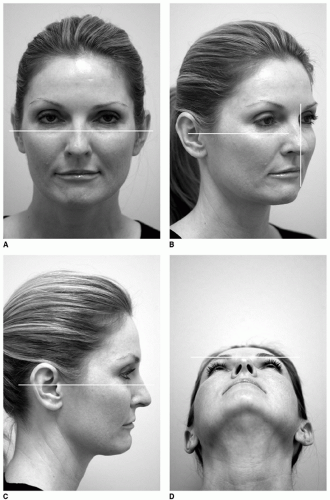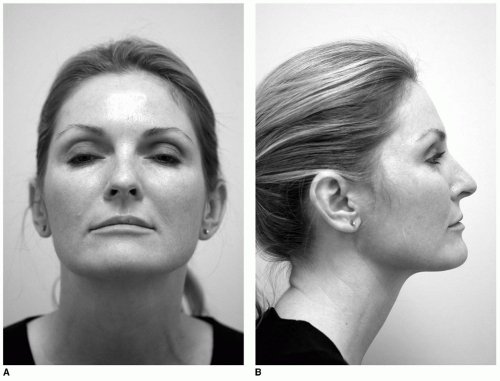In order for a photograph to carry any meaningful significance, the photographs must be standardized in the following manner: same photographic media, equipment, and settings; consistent patient positioning and absence of distracting elements (makeup, jewelry, hairstyle); and identical lighting and background. Besides these considerations, the same photographer (physician or staff member) should try to take all of the photographs because slight individual interpretation of these rules can lead to dissimilar photographic results. Before taking the postoperative images, the photographer should also review the preoperative images and then alter the necessary parameters to match the preoperative photographs. For example, if the preoperative oblique view shows that the patient is turned too far laterally, the photographer should try to match the same patient positioning (albeit less than ideal) in order that the postoperative image can be meaningfully compared.
Standardized Patient Positioning and Related Information
Proper patient positioning is the most demanding aspect of achieving reproducible photographic images. The same camera-to-subject distance must be maintained: this objective can be attained by placing the patient’s stool and the camera over prescribed markings on the floor (
Fig. 171.1). By using a fixed lens, that is, a lens that has no “zoom” capacity, the physician can also minimize any distortion and variability caused by altering the focal distance. The Frankfort Horizontal Plane must also be observed: the line that runs from the supratragal point through the inferior orbital rim defines the horizontal plane of the image (
Fig. 171.2A-C). The Frankfort Horizontal Plane should be respected in the frontal, oblique, and lateral views. The basal view that is mandatory for rhinoplasty, malar augmentation, and midfacial trauma is defined by aligning the tip of the nose with the infrabrow line (
Fig. 171.2D). On the oblique view, the patient should also be turned to a certain angle by one of two methods: (a) align the inner canthus of the eye with the oral commissure or (b) align the nasal tip with the malar eminence (
Fig. 171.2). Whichever method is chosen, the surgeon should attempt to rely on the same method for all images. Another reliable technique to ensure that the patient turns to the correct angle each time is to place markers on the wall that indicate where the patient should turn and face for an oblique and lateral view. When turning to the oblique and lateral positions, the patient should rotate the entire body in alignment with the face and not just turn the head to those positions, which creates neck distortion, especially in the lateral view. A rotating stool with a low back (that does not enter the frame of the image) is ideal for this goal.
One of the most common errors encountered is patient positioning with the neck tilted upward and extended, especially in the more mature patient who wants to reduce the appearance of unwanted neck-tissue redundancy. In
addition to distortion of the neck, over- or underrotation of the neck can cause the nose to appear erroneously rotated or derotated, respectively, and would compromise any photography for rhinoplasty (
Fig. 171.3). Patients may also reflexively attempt to lift their brow if they have significant brow ptosis, making the pre- and postoperative result for browlift or upper blepharoplasty less meaningful. If the patient exhibits this behavior, the photographer should ask that the patient close his or her eyes forcefully and slowly open them until they appear fully open. This maneuver will help break the unwitting contribution of the frontalis muscle. The patient may also instinctively smile when posing for a photograph, so the photographer should gently remind the patient that no facial expression should be displayed.
Each type of planned surgical procedure mandates a different set of standardized positions with or without additional optional views (
Table 171.1) (
1). Besides patient positioning, distracting elements from jewelry, makeup, clothing, and hairstyling should also be minimized. All obstructive jewelry, for example, necklaces and pendulous earrings, should be removed. Turtlenecks and high-necked collars can also obstruct a straightforward view of the neck and should be pulled down or folded inward to enhance effective communication. All eyeglasses should be removed regardless of what facial surgery is being contemplated.
Hairstyling ideally should be pulled back to show an unobstructed view of the eyes, nose, ears, lips, and neck and to be reduced to an unobtrusive element. Shorter hairstyles that do not interfere with any of the major facial features and the neck can be left alone or swept behind the helix of the ear as needed. All makeup should be removed, especially if any dermatologic resurfacing or scar revision is planned.
Lighting and Background
Lighting is also a critical element that should be standardized. Ambient lighting can be used alone or combined with fill lights or flash strobes. If the ambient lighting is too strong and casts a heavy shadow over the patient’s facial features, then balanced fill lighting can be used to soften these harsh shadows. Hot lights positioned at
45 degrees in front on both sides of the patient can be further softened by aiming the lights away toward reflective umbrellas. A “kicker” light placed behind the patient can fill in any remaining shadows cast by the two forward placed 45-degree lamps and slaved to go off when the camera’s shutter is depressed (
Fig. 171.4). Placing the patient an appropriate distance away (˜2 feet) from the rear wall can also minimize unwanted shadows. Generally, an oncamera flash tends to cause excessive highlights and shadows and a “washed-out” appearance to skin tones, but experimentation will determine the best balance of lighting for a particular room and camera. Rather than use fill lights or strobes, the ambient lighting and the camera’s aperture/exposure can be adjusted to achieve the desired lighting objective. Furthermore, the ambient room lighting can be altered to match the color spectrum (e.g., daylight balanced) of the film used or the settings of the camera so that, for example, a green cast from fluorescent lights may be avoided. If shadows and highlights are desired in order to accentuate a scar or other contour irregularity, for example, prominent nasolabial lines for correction with a soft tissue filler, then the balanced fill lights (if used) should be turned off. In addition, the exposure value can be reduced in order to draw out the intended feature. Obviously, the same settings should be used for the postoperative views.






